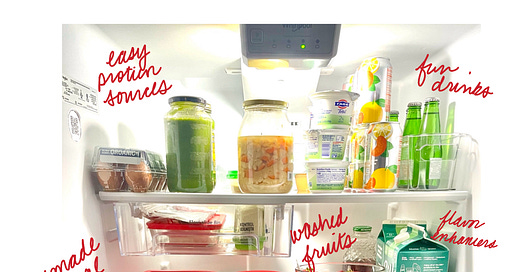I am taking on virtual nutrition counseling clients! If you or someone you know is struggling with their relationship with food, consider booking a free Discovery call to see what it is like working with an IFS-informed dietitian.
On any given week, a peek into my fridge will look very different. Ingredients for meals will change with the season and how much time I have for cooking that week. But all foods that cross the fridge threshhold have a purpose and today I will introduce you to a key question to help make your food life easier:
What does food need to do for me this week?
Do they need to be pre-cooked? Do they need to be comforting? Do they need to fuel a workout? Do they need to be delicious? Convenient? Cold? Hot?
I have included my “needs” below to help get your mind moving on this concept. All the foods I eat regularly fit into one of the below needs. It helps me ensure I have access to nutrient-dense foods but also tasty foods. This approach also helps me to think about foods differently, which can help me get new ideas each week!
My client’s and I often discuss meal planning at length and identify a specific plan that works best for them and their scheduling/nutrition needs — it can take some time to land on what approach works best for you so if you haven’t found ease with meal planning, don’t lose hope!
Without further ado, I need…
Foods with a plan
Ingredients needed to make meals
A variety of produce items (bonus points for numerous colors of produce items)
A few protein choices to last throughout the week (tofu, chicken, eggs, beef, etc.)
Pre-chopped/washed produce to make cooking easier
Ready-to-eat food
Leftovers or meal prep
Washed berries
Washed apples
Noka Smoothie pouches
Perfect Bars
Pasta sauce or parm/butter combo to whip together a quick sauce
Foods to make nutrient-dense choices easy:
Pre-made breakfast burritos (example from this week)
Batch cooked miso white beans (example from this week)
Batch cooked wild rice (example from this week)
A leafy green (change this weekly!)
Pre-made smoothie base
Veggies to eat raw (tomatoes, carrot sticks, cucumbers, olives, etc.)
Pickled vegetables
Flavor enhancers & joyful foods
Sauces, pickles, dressings, bullion
Iced tea
Iced coffee
100% juices
Cheeses
Lemon/lime juice
Jams/jellies
Capers
Tomato paste
Culturally-relevant foods:
Foods high in important, harder-to-get nutrients
Salmon (omega-3 fatty acids)
Kale, yogurt (calcium)
Soy milk (Vitamin D)
Potatoes (potassium)
Oatmeal muffins (fiber)
Nuts, seeds, nut butters (minerals and heart-supporting fats)
Bonus! Organization with food safety in mind:
Meats are housed in bins to prevent leaking onto other foods
Foods are cooked, eaten or frozen before the best buy/sell buy date
Leftovers are consumed within 3-5 days (according to most food safety experts, 5 days is pushing it on freshness).
Food is stored in glass containers as opposed to plastic
Temperature is maintained <40 degrees F
Non-perishable foods stored in the door (this is the warmest spot of the fridge)
Re-make the lists above with foods that work for your food preferences and your life! You might even have a look through your fridge and see where different items fall.
I will be coming back with a few more posts this fall all about meal planning and strategies to reduce the burden of meal planning—what questions do you have about feeding you and your family?
My husband is from Turkey!






i love this